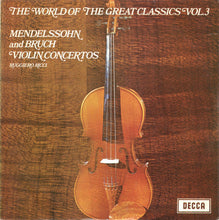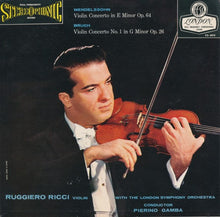Sonic Grade
Side One: 
Side Two: 
Vinyl Grade
Side One: Mint Minus Minus*
Side Two: Mint Minus Minus
- You'll find superb Double Plus (A++) sound or close to it on both sides of this vintage pressing
- The Bruch Violin Concerto takes up all of this Double Plus side two, and we guarantee it has more space, richness, and performance energy on this copy than others you've heard, and that's especially true if you made the mistake of buying whatever Heavy Vinyl pressing is currently on the market
- A truly wonderful 1958 All Tube "Decca Tree" recording from Kingsway Hall
More of the music of Felix Mendelssohn (1809-1847) / More of the music of Max Bruch (1838-1920)

100% Money Back Guarantee on all Hot Stampers
FREE Domestic Shipping on all LP orders over $150
*NOTE: There is a mark that plays 11 times lightly about 1/2" from the end of side 1, "Concerto in E Minor (Mendelssohn)."
In Ruggiero Ricci's hands, both works are nothing short of magical. The skill and the emotion of the playing is communicated beautifully on this LP.
This vintage Decca pressing has the kind of Tubey Magical Midrange that modern records can barely BEGIN to reproduce. Folks, that sound is gone and it sure isn't showing signs of coming back. If you love hearing INTO a recording, actually being able to "see" the performers, and feeling as if you are sitting in the studio with the band, this is the record for you. It's what vintage all analog recordings are known for -- this sound.
If you exclusively play modern repressings of vintage recordings, I can say without fear of contradiction that you have never heard this kind of sound on vinyl. Old records have it -- not often, and certainly not always -- but maybe one out of a hundred new records do, and those are some pretty long odds.
What The Best Sides Of This London Blueback Have To Offer Is Not Hard To Hear
- The biggest, most immediate staging in the largest acoustic space
- The most Tubey Magic, without which you have almost nothing. CDs give you clean and clear. Only the best vintage vinyl pressings offer the kind of Tubey Magic that was on the tapes in 1958
- Tight, note-like, rich, full-bodied bass, with the correct amount of weight down low
- Natural tonality in the midrange -- with all the instruments having the correct timbre
- Transparency and resolution, critical to hearing into the three-dimensional studio space
String Tone
It's practically impossible to hear that kind of string sound on any recording made in the last thirty years (and this, of course, includes everything pressed on Heavy Vinyl). It may be a lost art but as long as we have these wonderful vintage pressings to play, it's an art that is not lost on us.
I don't think the Decca engineers could have cut this record much better. This is the kind of record that will make you want to take all your Heavy Vinyl classical pressings and put them on ebay. They cannot begin to sound the way this record sounds. (Before you put them up for sale, please play them against this pressing so that you can be confident in your decision to rid yourself of their insufferable mediocrity.)
What We're Listening For On Concerto Recordings
- Energy for starters. What could be more important than the life of the music?
- The Big Sound comes next -- wall to wall, lots of depth, huge space, three-dimensionality, all that sort of thing.
- Then transient information -- fast, clear, sharp attacks, not the smear and thickness so common to these LPs.
- Next: transparency -- the quality that allows you to hear deep into the soundfield, showing you the space and air around all the instruments.
- Extend the top and bottom and voila, you have The Real Thing -- an honest to goodness Hot Stamper.
VTA and the Violin
This is truly the perfect turntable setup disc. When your VTA, azimuth, tracking weight and anti-skate are correct, this is the record that will make it clear to you that your efforts have paid off.
What to listen for you ask? With the proper adjustment the harmonics of the strings will sound extended and correct, neither hyped up nor dull; the wood body of the instrument will be more audibly "woody"; the fingering at the neck will be noticeable but will not call attention to itself in an unnatural way. In other words, as you adjust your setup, the violin will sound more and more right.
And you can't really know how right it can sound until you go through hours of experimentation with all the forces that affect the way the needle rides the groove. Without precise VTA adjustment there is almost no way this record will do everything it's capable of doing. There will be hardness, smear, sourness, thinness -- something will be off somewhere. With total control over your arm and cartridge setup, these problems will all but vanish. (Depending on the quality of the equipment of course.)
We harp on all aspects of reproduction for a reason. When you have done the work, records like this sound glorious.
Musical Credits
- Felix Mendelssohn - composer
- Max Bruch - composer
- Pierino Gamba - conductor
- Ruggiero Ricci - violin
- Accompanied by The London Symphony Orchestra
Vinyl Condition
Mint Minus Minus is about as quiet as any vintage pressing will play, and since only the right vintage pressings have any hope of sounding good on this album, that will most often be the playing condition of the copies we sell. (The copies that are even a bit noisier get listed on the site are seriously reduced prices or traded back in to the local record stores we shop at.)
Those of you looking for quiet vinyl will have to settle for the sound of other pressings and Heavy Vinyl reissues, purchased elsewhere of course as we have no interest in selling records that don't have the vintage analog magic of these wonderful recordings.
If you want to make the trade-off between bad sound and quiet surfaces with whatever Heavy Vinyl pressing might be available, well, that's certainly your prerogative, but we can't imagine losing what's good about this music -- the size, the energy, the presence, the clarity, the weight -- just to hear it with less background noise.
A Must Own Pair of Concertos
These wonderful violin concertos -- two of the greatest ever composed -- should be part of any serious Classical Collection.
Others that belong in that category can be found here.
Side One
- Mendelssohn: Concerto in E Minor
Side Two
- Bruch: Concerto No. 1 in G Minor
Mendelssohn Violin Concerto
A Romantic Masterpiece: Mendelssohn’s Violin Concerto
During the summer of 1838, Felix Mendelssohn wrote to his longtime friend and collaborator Ferdinand David: “I should like to write a violin concerto for you next winter. One in E minor runs through my head, the beginning of which gives me no peace.” Indeed, it would not give him peace for another six years, when he at last found time and inspiration amidst his busy concert schedule to complete it. He consulted David regularly throughout the composition process regarding violin technique and, ever the perfectionist, continued to make minor adjustments to the concerto unto its premiere in Leipzig on March 13, 1845. Composed at the height of Mendelssohn’s brilliant career, the concerto became an instant classic and remains one of the cornerstones of the repertoire.
The first movement, marked Allegro molto appassionato (Fast and very passionate), begins with a haunting melody that was likely the one Mendelssohn first imagined in 1838:
It easily conjures up the drama of misty heaths featured in contemporary novels by Sir Walter Scott and the Brönte sisters. The melody builds to a tempestuous transitional passage that subsides to reveal a new theme. Flutes and clarinets introduce this gentle, lyrical melody while the soloist plays a long pedal note on the violin’s lowest string. The violin then plays the melody, leading to a developmental passage.
The movement’s climax reveals one of Mendelssohn’s unique traits; while most composers create intensity with a fortissimo, Mendelssohn often makes the most crucial moments of his pieces the quietest. In this concerto, the development leads to a passage in which the violinist is completely alone. Normally, this extended solo (called a cadenza) appears at the end of a movement, but Mendelssohn placed it at the climactic turning point just after the middle. This innovation would inspire many later composers to do the same (Tchaikovsky, Sibelius and Rachmaninoff provide a few examples). Amid the soloist’s rapid string crossings, the haunting opening theme reappears in the orchestra. After the gentle second theme returns, the movement ends with a stormy coda.
Eager to create musical continuity throughout the concerto, Mendelssohn composed passages that link one movement to another without pause. As soon as the orchestra plays the final chord of the first movement, a bassoon leads a magical transition to the tranquil world of the slow second movement. The soloist then plays what many have described as a beautiful song without words, offering respite from the drama of the first movement. A contrasting, passionate melody appears in the middle of the movement, but ultimately the calm of the opening melody prevails.
The second movement transitions to the finale with a passage that at first evokes the moody atmosphere of the first movement. The soloist poses a series of musical questions which it answers along with the orchestra. Any clouds, however, are soon dispersed by playful brass fanfares that lead to a sunny, puckish theme for the soloist. Ever since he composed his Overture to A Midsummer Night’s Dream at 17, Mendelssohn had made this kind of scherzando, gossamer-textured “fairy music” a hallmark of his style. This main theme becomes the basis of a rondo, a musical form in which one main theme alternates with contrasting episodes. In the first such episode, a complimentary theme in B major is introduced by the orchestra. After the main theme returns, the soloist introduces a broader, contrasting melody. Mendelssohn reveals it to be an ingenious countertheme of the movement’s main melody when the violin and strings play them simultaneously. The complimentary theme returns in E major immediately afterward, leading to a final statement of the main theme and a thrilling coda.
Calvin Dotsey




